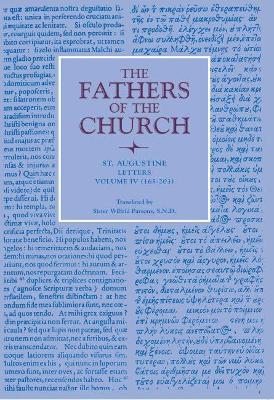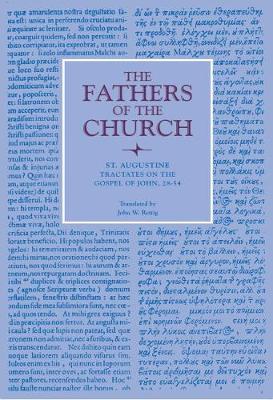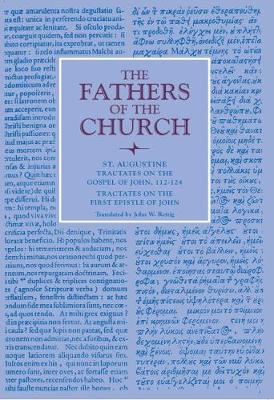Fathers of the Church: A New Translation (Patristic Series)
3 total works
The Letters appearing here in translation were written approximately between the years 410 and 420. This period in Augustine's life coincides with the ending of the long controversy with the Donatists and the spread of the Pelagian errors concerning nature and grace. When compared with earlier letters there is more emphasis in these letters on intellectual and doctrinal matters.
Perhaps the most important, and certainly the longest in this collection, (pp.141-190) is letter 185 addressed in 417 to the tribune Boniface. It gives a vivid description of the crimes committed by the Donatists against Catholics. Augustine writes: ""Some (Catholics) had their eyes put out; one bishop had his hands and tongue cut off; some were massacred. I say nothing of the inhuman beatings, of the looting of homes in nightly raids, of fires set not only to private homes but even to churches; and into these flames some even cast the sacred books"" (chapter 30).
The civil authorities eventually intervened in these disturbances and at times with coercive measures. Finally on January 30, 412 the Emperor Honorius made the profession of Donatism a criminal offense and ordered clerics and ministers of such heretics removed from the African soil which they had polluted by sacreligious rites. Though initially opposed to coercion, Augustine changed his view.
Perhaps the most important, and certainly the longest in this collection, (pp.141-190) is letter 185 addressed in 417 to the tribune Boniface. It gives a vivid description of the crimes committed by the Donatists against Catholics. Augustine writes: ""Some (Catholics) had their eyes put out; one bishop had his hands and tongue cut off; some were massacred. I say nothing of the inhuman beatings, of the looting of homes in nightly raids, of fires set not only to private homes but even to churches; and into these flames some even cast the sacred books"" (chapter 30).
The civil authorities eventually intervened in these disturbances and at times with coercive measures. Finally on January 30, 412 the Emperor Honorius made the profession of Donatism a criminal offense and ordered clerics and ministers of such heretics removed from the African soil which they had polluted by sacreligious rites. Though initially opposed to coercion, Augustine changed his view.
In his preaching, St. Augustine developed an oratorical style based on the classical rhetoric he had learned prior to his conversion which he adapted to the unique demands of Christian preaching. He still recognized the classical ends of rhetoric: to teach, to please, and to persuade. He gave, however, the place of most importance to content: what was said was more important than how it was said. He eschewed the more elaborate figures of speech, using a more direct manner to educate an audience that was, to a great extent, illiterate. The result, however, is not a debased Ciceronian style but a method of preaching that is clear, lively, and well-suited to its purpose.
Just as Augustine's oratorical style was subordinated to the demands of preaching the gospel of Christ, so also his method of commentary was similarly influenced by his duty as pastor at Hippo to instruct his flock in matters of faith and morals. His commentary, then, contains more than exegesis. His reflections on Scripture lead him to discussions of both moral action and dogma.
Augustine's extemporaneous style and broad range of interests are evident in the tractates included in this volume, in which he comments on chapters 7-12 of St. John's Gospel. These chapters contain some of the best-known episodes from the life of Christ: the encounter with the woman caught in adultery, the healing of the man born blind, the raising of Lazarus from the dead, Mary's anointing of Christ's feet, and Christ's triumphant entrance into Jerusalem. The passages also contain some of Christ's most explicit teaching of his divinity. In unfolding the mysteries contained in these chapters of St. John, Augustine moves easily from exegesis to reflections on moral virtue and doctrine, especially the Trinity and the Incarnation. But he never loses sight of his audience. Even in his comments on the loftiest of ideas, he strives to make the teaching accessible to all.
These tractates, then give us a glimpse of the man that we do not often get from his other works. Augustine's preaching shows us not only his brilliant mind and rhetorical skills as he expounds upon the Scriptures but also the great love he had for Christ and for the faithful entrusted to his care.
Just as Augustine's oratorical style was subordinated to the demands of preaching the gospel of Christ, so also his method of commentary was similarly influenced by his duty as pastor at Hippo to instruct his flock in matters of faith and morals. His commentary, then, contains more than exegesis. His reflections on Scripture lead him to discussions of both moral action and dogma.
Augustine's extemporaneous style and broad range of interests are evident in the tractates included in this volume, in which he comments on chapters 7-12 of St. John's Gospel. These chapters contain some of the best-known episodes from the life of Christ: the encounter with the woman caught in adultery, the healing of the man born blind, the raising of Lazarus from the dead, Mary's anointing of Christ's feet, and Christ's triumphant entrance into Jerusalem. The passages also contain some of Christ's most explicit teaching of his divinity. In unfolding the mysteries contained in these chapters of St. John, Augustine moves easily from exegesis to reflections on moral virtue and doctrine, especially the Trinity and the Incarnation. But he never loses sight of his audience. Even in his comments on the loftiest of ideas, he strives to make the teaching accessible to all.
These tractates, then give us a glimpse of the man that we do not often get from his other works. Augustine's preaching shows us not only his brilliant mind and rhetorical skills as he expounds upon the Scriptures but also the great love he had for Christ and for the faithful entrusted to his care.
Tractates on the Gospel of John, 112-124; Tractates on the First Epistle of John
by Saint Augustine
Published 18 December 2013
In this volume, which concludes John W. Rettig's translation of St. Augustine's Tractates on the Gospel of John, Augustine applies his keen insight and powers of rhetoric to the sacred text, drawing the audience into an intimate contemplation of Jesus through the course of his Passion, Death, and Resurrection.
Augustine clarifies the meaning of words and phrases (often appealing to the Greek text), resolves obscurities, and reconciles apparent contradictions. He explains the Scriptures on several levels of meaning and draws from them practical implications for the Christian life. Always evident in his teaching and exhortation is his strong desire to lead souls to a knowledge and love of God.
Because the scriptural readings for holy Week and the Octave of Easter were fixed to some extent, during the Easter Octave in A.D. 407 Augustine had to interrupt his exposition of John's Gospel after delivering the twelfth tractate. In order to maintain some continuity, he decided to preach upon the First Epistle of John. Its central theme, which Augustine saw to be caritas (Christian love), was especially appropriate at this time, for the Donatist schism had torn many away from the Church at Hippo. In the ten tractates on the First Epistle of John, Augustine develops an outline of his theology on love and explains its implications for the Mystical Body of Christ. He teaches that those who hate the members of Christ cannot truly love Christ--even if they profess otherwise, even if they were to lay down their lives for Him. In these tractates Augustine once again reveals himself as the humble and zealous pastor of souls. His words seem to radiate the very love about which he speaks, so that few of his listeners could accuse him of preaching what he himself did not practice.
Augustine clarifies the meaning of words and phrases (often appealing to the Greek text), resolves obscurities, and reconciles apparent contradictions. He explains the Scriptures on several levels of meaning and draws from them practical implications for the Christian life. Always evident in his teaching and exhortation is his strong desire to lead souls to a knowledge and love of God.
Because the scriptural readings for holy Week and the Octave of Easter were fixed to some extent, during the Easter Octave in A.D. 407 Augustine had to interrupt his exposition of John's Gospel after delivering the twelfth tractate. In order to maintain some continuity, he decided to preach upon the First Epistle of John. Its central theme, which Augustine saw to be caritas (Christian love), was especially appropriate at this time, for the Donatist schism had torn many away from the Church at Hippo. In the ten tractates on the First Epistle of John, Augustine develops an outline of his theology on love and explains its implications for the Mystical Body of Christ. He teaches that those who hate the members of Christ cannot truly love Christ--even if they profess otherwise, even if they were to lay down their lives for Him. In these tractates Augustine once again reveals himself as the humble and zealous pastor of souls. His words seem to radiate the very love about which he speaks, so that few of his listeners could accuse him of preaching what he himself did not practice.


